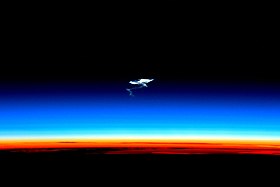
Back Stratosfeer Afrikaans Maladacay to’edip AMI ستراتوسفير Arabic ستراتوسفير ARZ Stratosfer Azerbaijani Стратасфера Byelorussian Стратосфера Bulgarian स्ट्रेटोस्फियर Bihari স্ট্রাটোমণ্ডল Bengali/Bangla སྙོམས་རྒྱུག་རིམ། Tibetan



The stratosphere (/ˈstrætəˌsfɪər, -toʊ-/) is the second-lowest layer of the atmosphere of Earth, located above the troposphere and below the mesosphere.[2][3] The stratosphere is composed of stratified temperature zones, with the warmer layers of air located higher (closer to outer space) and the cooler layers lower (closer to the planetary surface of the Earth). The increase of temperature with altitude is a result of the absorption of the Sun's ultraviolet (UV) radiation by the ozone layer, where ozone is exothermically photolyzed into oxygen in a cyclical fashion.[4] This temperature inversion is in contrast to the troposphere, where temperature decreases with altitude, and between the troposphere and stratosphere is the tropopause border that demarcates the beginning of the temperature inversion.
Near the equator, the lower edge of the stratosphere is as high as 20 km (66,000 ft; 12 mi), at mid-latitudes around 10 km (33,000 ft; 6.2 mi), and at the poles about 7 km (23,000 ft; 4.3 mi).[4] Temperatures range from an average of −51 °C (−60 °F; 220 K) near the tropopause to an average of −15 °C (5.0 °F; 260 K) near the mesosphere.[5] Stratospheric temperatures also vary within the stratosphere as the seasons change, reaching particularly low temperatures in the polar night (winter).[6] Winds in the stratosphere can far exceed those in the troposphere, reaching near 60 m/s (220 km/h; 130 mph) in the Southern polar vortex.[6]
- ^ "Atmospheric Temperature Trends, 1979–2005". NASA/Earth Observatory. 6 July 2007. Archived from the original on 5 September 2015. Retrieved 24 August 2015.
- ^ Jones, Daniel (2003) [1917], Peter Roach; James Hartmann; Jane Setter (eds.), English Pronouncing Dictionary, Cambridge: Cambridge University Press, ISBN 978-3-12-539683-8
- ^ "Stratosphere". Merriam-Webster.com Dictionary.
- ^ a b "The Stratosphere - overview". scied.ucar.edu. University Corporation for Atmospheric Research. Retrieved 25 July 2018.
- ^ "NWS JetStream - Layers of the Atmosphere". www.weather.gov.
- ^ a b "Nasa Ozone Watch: Polar vortex facts". ozonewatch.gsfc.nasa.gov.
© MMXXIII Rich X Search. We shall prevail. All rights reserved. Rich X Search